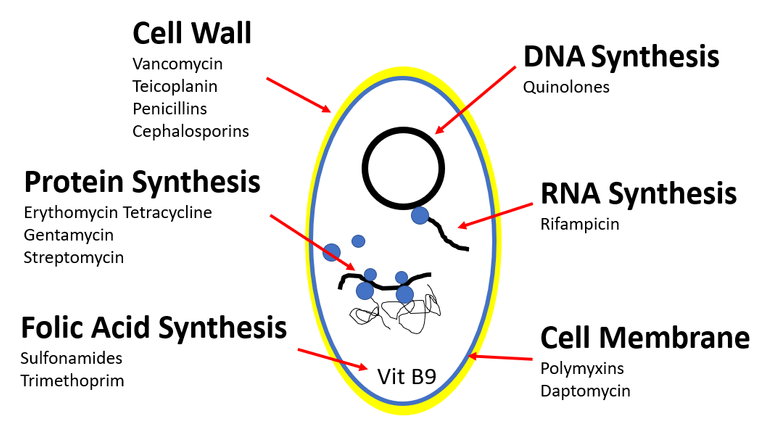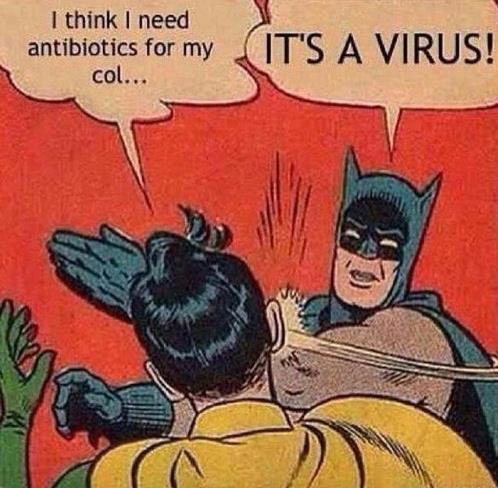Recently I wrote an article about Antibiotics where I also mentioned problems associated with misuse of antibiotics and rise of so called super bugs. In the comments section of this article @pmduy shared an article about great method that can differentiate between viral and bacterial infection in matter of minutes!
Therefore, I decided I want to share what I found out.

Basics
First thing first. Maybe you know all of this, but try to answer to these questions:
1. What is the difference between bacteria and viruses?
2. What are antibiotics?
3. Would you use antibiotics to treat viral or bacterial infection?
4. What are super bugs?
If you are uncertain with at least one answer, then read on!
1. Bacteria vs Viruses
So, viruses. They are basically DNA/RNA coated in proteins and lipids. This means that they are unable to metabolize anything and can’t even reproduce on their own. The important thing - they are not cellular organisms!
Bacteria on the other hand are prokaryotic unicellular microorganisms. That means that they are very small organisms that we cannot see with naked eye and their cellular composition drastically differs from cellular composition of for example yeast (that is eukaryotic organism). The main difference is in the absence of any membrane bound organelles (something like cellular organs) in prokaryotes and thus bacteria. Read more about this HERE.

2. Antibiotics
Antibiotics are basically a defense system or a chemical weapon of the host organisms against other lifeforms (such as bacteria). To be more specific, they are mall metabolites of microorganisms with molecular mass bellow 2000, which even at low concentrations inhibit growth of other microorganisms, but not the producer. Their mechanism of action is to hinder cellular functions – such as protein synthesis, or destruction of cell wall (see bellow). More about it in my article HERE.

3. Use of antibiotics
Now, do you remember that viruses are non-cellular organisms? And that antibiotics hinder cellular functions? So, the answer is that antibiotics are not effective against viruses (REMEMBER THAT!). Antibiotics are only good to destroy cellular organisms such as bacteria!

Source
4. Superbugs
Even though antibiotics drastically improved our lives they also gave rise to so called super bugs - bacteria resistant to antibiotics. This was mainly caused by misuse and spread of antibiotics and that created a huge evolutionary pressure on bacteria, thus accelerating their own evolution. Around 25 000 deaths annually in Europe are due to super bugs – YES, they are big problem. Therefore, it is very important to use antibiotics only when necessary and have proper diagnostic tools to differentiate between viral and bacterial infections.
To the point
Now that you have all the necessary background information lets head to the core of the article. As I mentioned there is need for quick tool that could differentiate between bacterial and viral infection. Of course, there are blood tests that can do this, but they are usually lengthy and have to be performed in separate labs – not in doctor’s office.
And here comes the MINICARE HNL - a handheld device that needs only a drop of blood to diagnose this. It is based on the detection of Human Neutrophil Lipocalin (HNL) that is released by blood cells when there is bacterial infection. However, HNL is not released in the presence of viral infection. The test takes less than ten minutes to result. And the procedure to obtain the blood is a finger prick test - minimizing the invasiveness.
The technology is a collaboration between P & M Venge AB (a Swedish medical research company) and Philips Diagnostics in the Netherlands. It should be available to physicians in 2018. The device is affordable for the doctor's office and is fairly easy to use.
Concluding remarks
Such technology could greatly diminish the misuse of antibiotics in the world. Thus, there will be less deaths and superbugs. And we will have more functioning antibiotics to use in times of need – organ transplant, hip replacements, or cancer.
Have a great day and once again, thanks @pmduy!
References:
https://horizon-magazine.eu/article/finger-prick-test-wins-eur-1-million-fight-antibiotic-resistance_en.html
http://ec.europa.eu/research/horizonprize/index.cfm?prize=better-use-antibiotics
Being A SteemStem Member
this is a real post, on steemit. it's just cool I can say that this is a "super^
This is a very novel information for me regarding how to differentiate bacteria or virus infection. Thanks for sharing. I would share this news to doctors at my working area. Can we find the minicare HNL in the market?
It is still a work in progress, but should be hit the market in 2018 - or so the press claims. :)
Great post :)
I'd be interested in the sensitivity and specificity of MINICARE HNL.... I know how common it is for patients to have an irrelevant bacteraemia that we just ignore because it's clinically irrelevant. The same can be said of active by asymptomatic viral infections :)
I am glad you liked it!
And that is a good point, did not think about that. Hmmm, maybe there are some basal levels of HNL proteins and only acute bacterial infections increase it to abnormal values? Just guessing. :D
Haha good point :)
My issue with these rapid diagnostic tools is the incidence of false positive results. On a probability scale of 1-100, how accurate will this tool be?
Well, that is good question and I have no answer. But before using this device with patients there will be plenty of clinical trials for sure. It is still a technology of tomorrow, but the prospect of such technology sounds amazing.